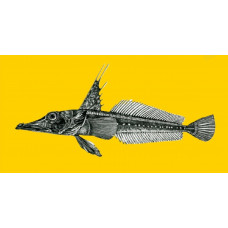Latin name
Channichthys panticapaei
Other name
Channichthys panticapaei
Identification
Charcoal icefish is distinguished from other species of the genus Channichthys by the following set of characters. In the dorsal (upper) lateral line 64-83 tubular bony segments (scales), in the posterior part of the medial (middle) lateral line 7-23 tubular bony segments (scales), in the anterior part 4-27 punctate rounded bony plates; in the lower part of the gill arch 2 rows of stamens. Total number of stamens 18-31, of which 11-17 in the outer row and 6-15 in the inner row; vertebrae 55-57, of which 23-24 trunk vertebrae and 31-33 caudal vertebrae. The posterior edge of the jawbone extends posteriorly to a vertical line passing through the centre of the orbit. Granulation (tuberculation) on the body is very strong, the fine sharp bony granules giving the fish a strong roughness. Granulation is particularly pronounced on the head, especially the frontal bones, the posterior part of the jawbone and the anterior part of the dentition, the first four or five barb rays of the first dorsal fin, the rays of the gill membrane and the bony plates of the lateral lines. The anterior part of the medial lateral line has very dense, rounded, punctate bony plates. In the lower part of the first gill ray, the well-developed stamens, densely covered with bony denticles, are always arranged in 2 rows.
Features of fish fins
The first dorsal fin has 6-8 flexible barb rays, of which the 2nd and 3rd are the largest; the second dorsal fin has 32-34 rays; the anal fin has 30-32 rays; the pectoral fin has 20-22 rays.
The first dorsal fin is high, its height is 3.2-5.1 times the standard length of the fish, more or less triangular in shape (not trapezoidal), with a very low fin fold, reaching a height no higher than 3/4 of the length of the largest barb. The first and second dorsal fins are separated by a wide interdorsal space. Interorbital space very large (19-23% of head length), flat, usually larger than the diameter of the orbit.
Fish colouring
The overall body colouration of live fish varies from dark grey with characteristic marbled spots to almost black. The lower part of the body and narrow areas along the base of the anal fin are usually lighter, and in immature fish almost white, with slight pigmentation. Spiny rays and fin fold of first dorsal fin dark, almost black. Rays of second dorsal, pectoral and caudal fins dark brown, fin rays pale. Anal fin pale, with dark spots in distal part of rays. Pelvic fins dark from top, slightly lighter towards the edges, sometimes with light spots and transverse black stripes.
Distribution
The known range of the species includes the coastal marine waters around the Kerguelen Islands (endemic).
Habitat
A deep-sea bottom-dwelling marine species, its habitat depth range is 112-154 m.
Size
It belongs to the group of medium-sized species of the genus Channichthys. The largest females reach a total length of 402 mm and a standard length of 361 mm. The largest males do not exceed 394 mm total length and 354 mm standard length.
Behavior
Leads a demersal lifestyle.
Food and feeding habits
Macrozooplanktophagus, apparently feeding on the surface and in the bottom layers of the water. Amphipods (Themisto gaudishaudi) and small euphausiids (Thysanoessa macrura) have been found in the stomachs of the fish. Like other zooplankton feeders, Channichthys has numerous gill stamens arranged in two rows on the lower part of the first gill arch.
Reproduction
Sexual maturity does not occur until the fish is about 30 cm in total length (27 cm standard length). Spawning takes place during the southern hemisphere winter, June-July. By the second half of July 1990, almost all fish had spawned. Gonads in a fluid state (stage V of maturity) were found in a few males. In 2 females unfertilised eggs with no signs of resorption were observed in the ovaries. In the largest female, with a total length of 402 mm, the gonads were in a pre-spawning state (stage IV-V).
Fishing
The Kerguelen Islands' fishery for Chamsocephalus gunnari Lönnberg, 1905, better known by its commercial name "icefish", may result in by-catches of charcoal icefish.
Relationship with a person
Harmless.
| Classification | |
| Phylum | Chordata |
| Class | Actinopterygii |
| Squad | Perciformes |
| Family | Channichthyidae |
| Genus | Channichthys |
| Species | C. panticapaei |
| Features | |
| Conservation status | Not Evaluated |
| Habitat | Bottom |
| Life span, years | No information |
| Maximum body weight, kg | No information |
| Maximum length, cm | 40,2 |
| Sailing speed, m/s | No information |
| Threat to people | Edible |
| Way of eating | Planktonophage |
Charcoal icefish
Tags: charcoal icefish

